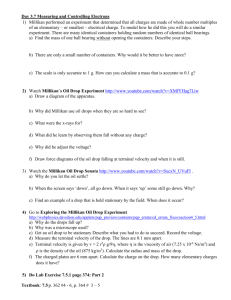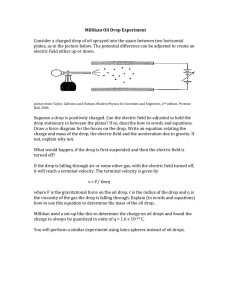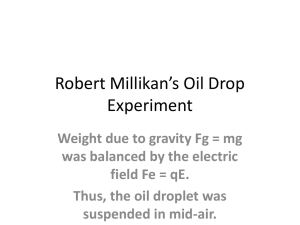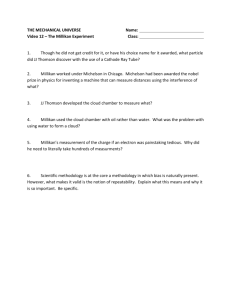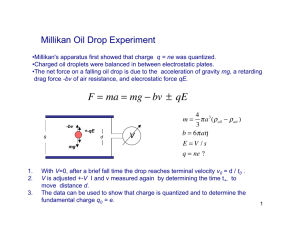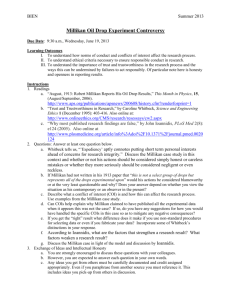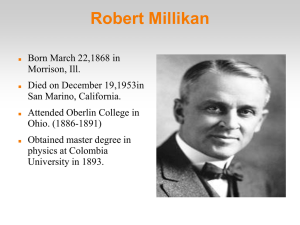Millikan`s Oil Drop Experiment
advertisement
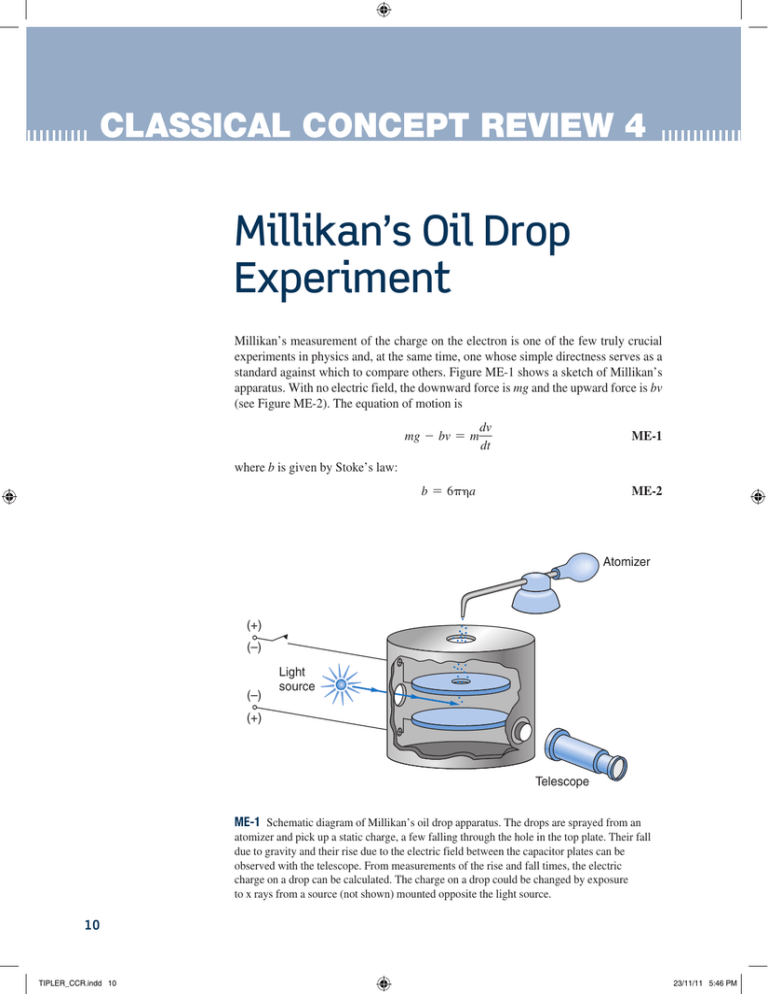
CLASSICAL CONCEPT REVIEW 4 Millikan’s Oil Drop Experiment Millikan’s measurement of the charge on the electron is one of the few truly crucial experiments in physics and, at the same time, one whose simple directness serves as a standard against which to compare others. Figure ME-1 shows a sketch of Millikan’s apparatus. With no electric field, the downward force is mg and the upward force is bv (see Figure ME-2). The equation of motion is mg - bv = m dv dt ME-1 where b is given by Stoke’s law: ME-2 b = 6pa Atomizer (+) (–) (–) Light source (+) Telescope ME-1 Schematic diagram of Millikan’s oil drop apparatus. The drops are sprayed from an atomizer and pick up a static charge, a few falling through the hole in the top plate. Their fall due to gravity and their rise due to the electric field between the capacitor plates can be observed with the telescope. From measurements of the rise and fall times, the electric charge on a drop can be calculated. The charge on a drop could be changed by exposure to x rays from a source (not shown) mounted opposite the light source. 10 TIPLER_CCR.indd 10 23/11/11 5:46 PM Classical Concept Review 4 where is the coefficient of viscosity of the fluid (air) and a is the radius of the drop. The terminal velocity of the falling drop vf is mg ME-3 b When an electric field is applied, the upward motion of a charge qn is given by vf = qn - mg - bv = m dv dt vr = Buoyant force bv Droplet e Weight mg Thus, the terminal velocity vr of the drop rising in the presence of the electric field is 11 qn - mg b ME-4 ME-2 An oil droplet carrying a charge e falling at terminal velocity; that is, mg = bv. In this experiment, the terminal speeds were reached almost immediately, and the drops drifted a distance L upward or downward at a constant speed. Solving Equations ME-3 and ME-4 for qn, we have qn = mgTf 1 mg 1 1vf + vr 2 = a + b vf Tf Tr ME-5 where Tf = L>vf is the fall time and Tr = L>vr is the rise time. If any additional charge is picked up, the rising terminal velocity becomes v r= , which is related to the new charge q n= by Equation ME-4: v r= = q n= - mg b The amount of charge gained is thus q n= - qn = = mg = 1v r - vr 2 vf mgTf a 1 1 b = Tr Tr ME-6 The velocities vf, vt, and v r= are determined by measuring the time taken to fall or rise the distance L between the capacitor plates. If we write qn = ne and q n= - qn = n9e, where n9 is the change in n, Equations ME-5 and ME-6 can be written and 1 1 1 e a + b = n Tf Tr mgTf 1 1 1 e a = + b = n9 T r Tr mgTf ME-7 ME-8 To obtain the value of e from the measured fall and rise times, one needs to know the mass of the drop (or its radius, since the density is known). The radius is obtained from Stoke’s law using Equation ME-3. Notice that the right sides of Equations ME-7 and ME-8 are equal to the same constant, albeit an unknown one since it contains the unknown e. The technique, then, was to obtain a drop in the field of view and measure its fall time Tf (electric field off) TIPLER_CCR.indd 11 23/11/11 5:46 PM 12 Classical Concept Review 4 and its rise time Tr (electric field on) for the unknown number of charges n on the drop. Then, for the same drop (hence, same mass m), n was changed by some unknown amount n9 by exposing the drop to the x-ray source, thereby yielding a new value for n. Tf and Tr were then re-measured. The number of charges on the drop was changed again and the fall and rise times recorded. This process was repeated over and over for as long as the drop could be held in view (or until the experimenter became tired), often for several hours at a time. The value of e was then determined by finding (basically by trial and error) the integer values of n and n9 that made the left sides of Equations ME-7 and ME-8 equal to the same constant for all measurements using a given drop. Millikan did experiments like these with thousands of drops, some of nonconducting oil, some of semiconductors such as glycerine, and some of conductors such as mercury. In no case was a charge found that was a fractional part of e. This process, which you will have the opportunity to work with in solving Problem ME-1 using actual data from Millikan’s sixth drop, yielded a value of e to be 1.591 10219 C. This value was accepted for about 20 years until it was discovered that x-ray diffraction measurements of NA gave values of e that differed from Millikan’s by about 0.4 percent. The discrepancy was traced to the value of the coefficient of viscosity used by Millikan, which was too low. Improved measurements of gave a value about 0.5 percent higher, thus changing the value of e resulting from the oil drop experiment to 1.601 10219 C, in good agreement with the x-ray diffraction data. The modern determinations of the “best” value of e and other physical constants are published periodically by the International Council of Scientific Unions. The currently accepted value of the electron charge is e = 1.60217653 * 10-19 C ME-9 with an uncertainty of 0.14 parts per million. Our needs in this book are rarely as precise as this, so we will typically use e = 1.602 10219 C. Note that, while we have been able to measure the value of the quantized electric charge, there is no hint in any of the above as to why it has this value, nor do we know the answer to that question now. Problem ME-1. Tabulated below is a portion of the data collected by Millikan for drop number 6 in the oil drop experiment. (a) Find the terminal fall velocity vf from the table using the mean fall time and the fall distance (10.21 mm). (b) Use the density of oil r = 0.943 g>cm3 = 943 kg>m3, the viscosity of air = 1.824 * 10-5 N@s>m2, = 2.5 * 106 V>m, and g = 9.81 m>s2 to calculate the radius a of the oil drop from Stoke’s law as expressed in Equation ME-2. (c) The correct “trial value” of n is filled in column 7. Determine the remaining correct values for n and n9 in columns 4 and 7 respectively. (d) Compute e from the data in the following table. TIPLER_CCR.indd 12 23/11/11 5:46 PM Classical Concept Review 4 13 Table ME-1 Rise and fall times of a single oil drop with calculated number of elementary charges on drop 1 2 3 4 5 6 7 8 Tf Tr 1/T9r − 1/Tr n9 1/n9 (1/T9r − 1/Tr) (1/Tf + 1/Tr) n 1/n (1/Tr − 1/Tf) 0.09655 18 0.005366 11.848 80.708 11.890 22.366 11.908 22.390 11.904 22.368 11.882 0.03234 6 0.005390 0.12887 24 0.005371 140.566 0.03751 7 0.005358 0.09138 17 0.005375 11.906 79.600 0.005348 1 0.005348 0.09673 18 0.005374 11.838 34.748 0.01616 3 0.005387 0.11289 21 0.005376 11.816 34.762 TIPLER_CCR.indd 13 23/11/11 5:46 PM
